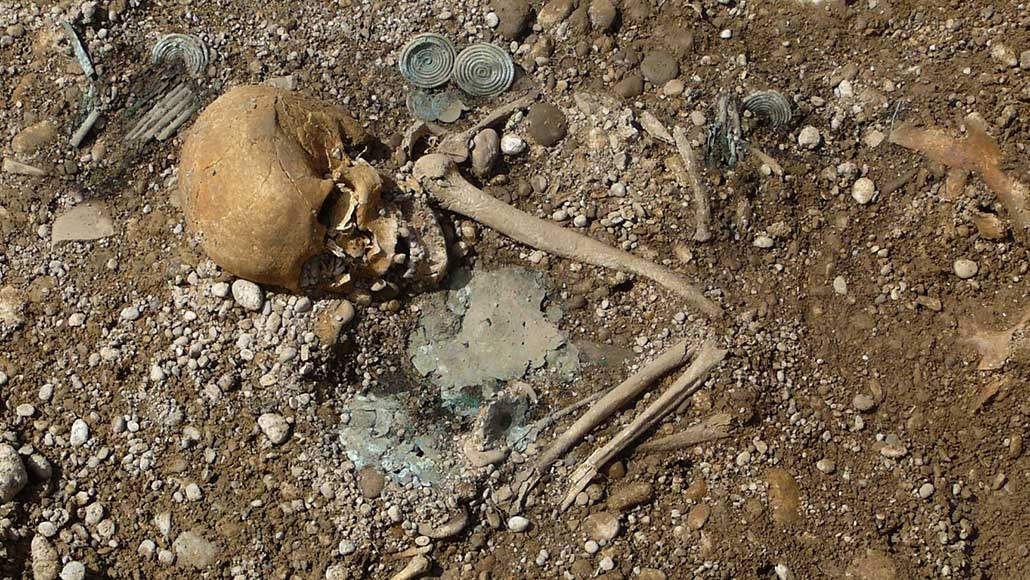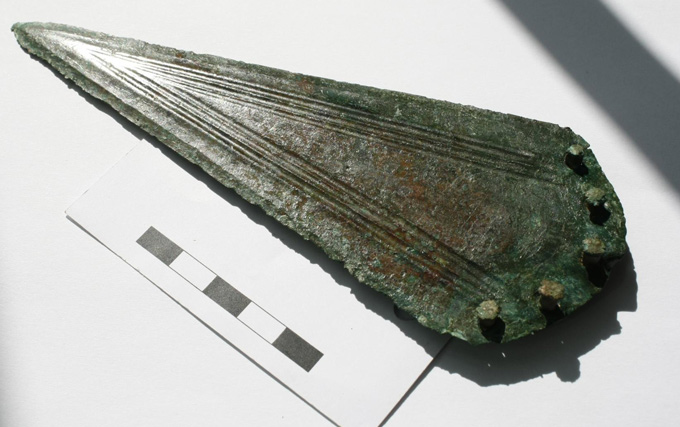Ancient European households combined the rich and poor
A new study challenges traditional views of ancient social stratification

A Bronze Age woman buried with elaborate jewelry and a headdress in southern Germany had come from several hundred kilometers away, researchers say. The woman apparently married into a local farm household that included high- and low-status individuals.
ABK Süd
Families working the land in ancient Europe also cultivated social inequality. A social pecking order consisting of “haves” and “have-nots” living in the same household appeared among Bronze Age farmers by around 4,000 years ago, a study suggests.
Ancient DNA, objects placed in graves and chemical analyses of teeth indicate that each farming household in southern Germany’s Lech Valley included wealthy individuals related biologically through paternal lines; a biologically unrelated, high-status woman from outside the area; and local, biologically unrelated folks of little means.
Foreign women probably married into male-run households that passed on wealth and status to descendants, say evolutionary geneticist Alissa Mittnik of Harvard Medical School and colleagues. Poor, low-status members of those households may have been servants, slaves or menial laborers, the researchers suggest online October 10 in Science.
Researchers have long assumed that central Europe’s Bronze Age (SN: 11/15/17), which ran from about 4,200 to 2,800 years ago, witnessed rapid social change that prompted a split between wealthy, well-connected households and poor, struggling ones, says archaeologist and study coauthor Philipp Stockhammer.
“We were absolutely surprised to find that social inequality was a phenomenon within households rather than between households,” says Stockhammer, of the Max Planck Institute for the Science of Human History in Jena, Germany.
Members of these social units identified with their households regardless of their biological roots or economic standing, the researchers suspect. Lech Valley farmers did not live in villages. Instead, a small group of houses and other structures, comprising a household, was usually situated near a cemetery. Households managed individual tracts of land located within a 20-kilometer-long stretch of fertile soil.
Bronze Age farms foreshadowed family arrangements starting nearly 1,000 years later in ancient Greece and Rome, Stockhammer says. Households in those societies mixed a nuclear family with other biological relatives and slaves.
Mittnik’s group extracted DNA from the skeletons of 118 people buried in five Lech Valley cemeteries dating to between 4,750 and 3,300 years ago. An analysis of biological relationships among 104 individuals enabled a reconstruction of six family trees spanning four to five generations.
A specific household arrangement appeared nearly 4,200 years ago, shortly after the Bronze Age began. Of six pedigrees reconstructed by the team, three spanned at least four generations. Of 10 pairs of parents and offspring, only male offspring were detected. All except one was an adult. Daughters apparently left the farms where they had grown up by young adulthood. Mothers had originally come from at least 350 kilometers away. Different forms of strontium and oxygen in tooth enamel, which provide clues to where a person was born and raised, denoted mothers’ foreign origins.
Weapons and ornate jewelry were found in the graves of closely related family members and women who had come from afar. Graves of genetically unrelated household members, who had local origins, contained few artifacts and those items were of limited value.

Lech Valley farms were passed from generation to generation over at least 700 years, the researchers conclude. “It’s difficult to say whether these inheritance rules were new or the continuation of an older system of wealth inheritance in male lines,” Stockhammer says.
Mittnik’s team provides “a unique case study” of wealth inequality and inheritance during southern Germany’s Bronze Age, says archaeologist Amy Bogaard of the University of Oxford. If unrelated, low-status household members were slaves, they also may have been inherited across generations, she suggests.
But the study lacks evidence of slavery, contends anthropologist Bettina Arnold of the University of Wisconsin–Milwaukee. It’s more likely that some male lineages had more children and stronger strategic alliances than others, enabling successful lines to accumulate wealth and workers, Arnold says. Overall, the Lech Valley sample is too small to reach any general conclusions about Bronze Age social practices in central Europe, she adds.
Still, Mittnik’s group demonstrates an early start for powerful male lineages that used foreign contacts to find wives, Arnold says. That practice may eventually have led to social systems mandating unequal treatment for men and women, she suspects.







